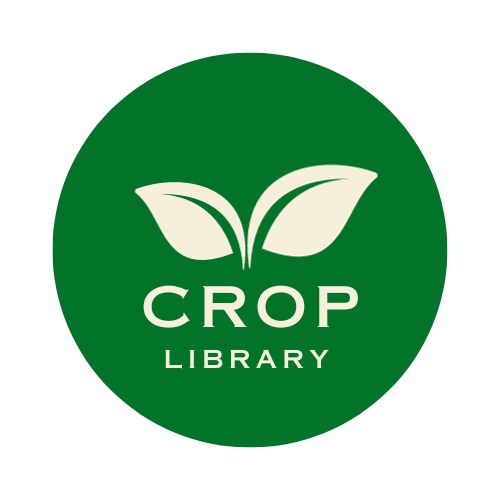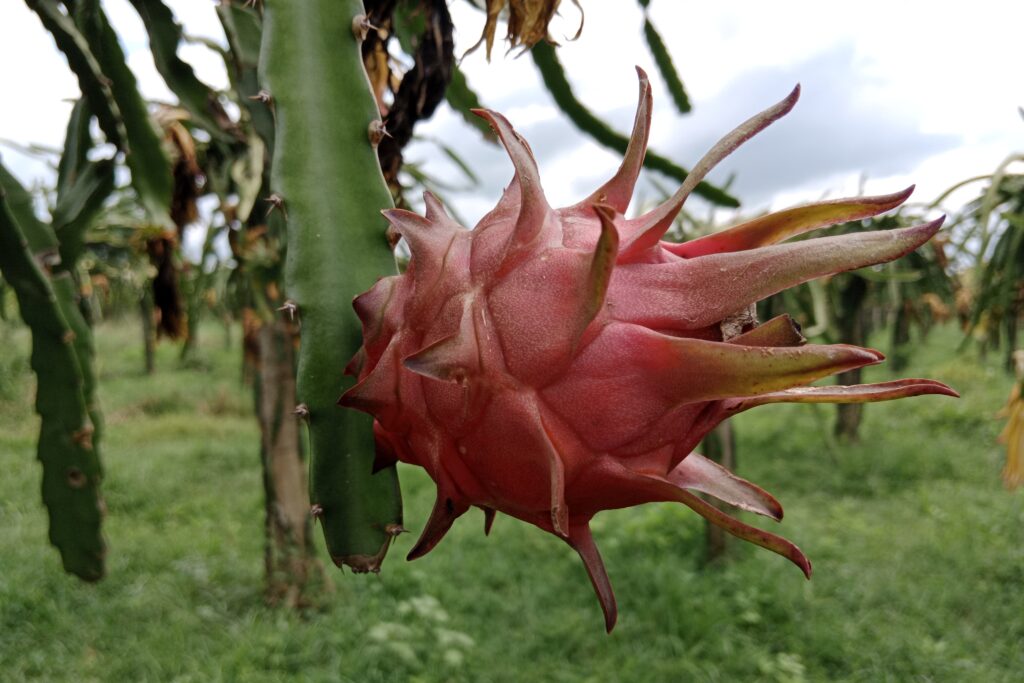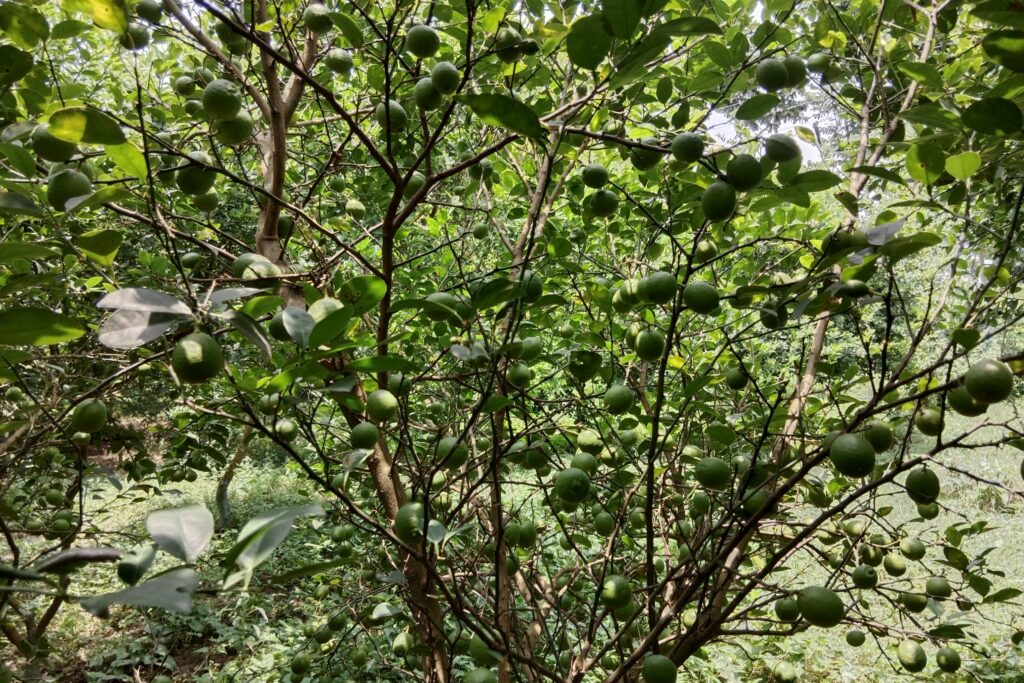Jamun Farming
Jamun (Syzygium cumini), commonly known as Java plum or Indian blackberry, is a highly nutritious, drought-resistant fruit tree native to the Indian subcontinent. Renowned for its medicinal value in managing diabetes and liver disorders, this antioxidant-rich crop offers excellent jamun farming profit per acre potential. Farmers can choose between two cultivation models: low-density planting (40 plants/acre) yields ~NRs. 6,000,000+ over 40 years with NRs. 2,000,000 total costs (NRs. 4,000,000+ net profit), while high-density cultivation (162 plants/acre) delivers ~NRs. 12,000,000+ income (NRs. 8,000,000+ net profit) despite requiring 86% higher initial investment.

Though the tree’s natural height (25-30m) poses harvesting challenges, proper canopy management and the use of grafted varieties make it commercially viable. Its dual advantage of therapeutic value and consistent jamun farming profit per acre (up to NRs. 450,000 annually during peak years) makes it an attractive crop for both small-scale and commercial growers. Below is a comprehensive guide to optimizing jamun cultivation practices for maximum profitability.
Land Preparation
Jamun adapts well to diverse soil conditions but performs best in well-drained land. Begin by clearing the field of weeds, rocks, and other debris. Plow the soil deeply 2-3 times to achieve a fine, even texture and proper leveling. Most importantly, ensure adequate drainage systems are in place to prevent waterlogging, as this is critical for promoting strong root growth and optimal plant development.
Soil Type
Soil Requirements for Jamun Cultivation: Jamun grows best in fertile loamy or alluvial soils rich in organic matter, with an ideal pH range of 6.5 to 7.5 (slightly acidic to neutral). Heavy clay or waterlogged soils should be avoided as they restrict proper root growth and development. Well-drained soil with good aeration is essential for optimal jamun production.
Climatic Requirements
Climatic Requirements for Jamun Cultivation: Jamun thrives in tropical and subtropical climates, preferring temperatures between 25-35°C for optimal growth. The tree is drought-resistant but requires 750-1000 mm annual rainfall, with dry weather during flowering and fruiting stages for better yield. While mature trees can withstand brief temperature drops to 0°C, frost during flowering damages fruit set. Jamun adapts well to various altitudes up to 1500m, making it suitable for cultivation across diverse geographical regions.
Major Cultivars
To maintain the dwarf framework of the jamun tree, toping of main stem (4–6 m) is needed which also facilitates easy harvesting of the fruits.

a). Narendra Jamun-6 (Seedless)
This high-yielding variety produces less fibrous, seedless fruits, making it popular for fresh consumption. Its improved texture and absence of seeds enhance marketability while maintaining good productivity.
b) Goma Priyanka
Known for its large-sized fruits with excellent pulp content, this semi-dwarf variety features a spreading growth habit. Its compact stature (4-6m after topping) makes it ideal for high-density commercial plantations while facilitating easier harvests.
c) Ra Jamun
An early-maturing variety prized for its naturally sweet flavor profile. Its quicker harvest cycle and dessert-quality fruits make it preferable for fresh fruit markets compared to tart varieties.
d) Kaatha Jamun
Characterized by its sour taste, this cultivar is primarily used for processed products like vinegar, pickles, and medicinal preparations rather than fresh eating. Its acidity lends well to value-added food products.
e) Black Pearl
A commercial favorite due to its reliable high yields of quality fruits. This variety combines productivity with good fruit characteristics, making it a profitable choice for orchard-scale cultivation.
Planting
a). Planting Season
Planting Season for Jamun: The ideal time for planting jamun is during the monsoon season from June to September, when natural rainfall ensures proper establishment of young saplings. However, in areas with reliable irrigation facilities, planting can also be successfully undertaken during the spring months of February-March, allowing the plants to establish roots before the intense summer heat. Both seasons provide favorable conditions for root development, though monsoon planting generally requires less supplemental watering.
b). Spacing
For traditional jamun orchards with large-growing varieties, a standard spacing of 10m × 10m is recommended to accommodate the tree’s mature canopy size, while high-density planting using dwarf or semi-dwarf cultivars like Goma Priyanka can be spaced closer at 5m × 5m, allowing for more trees per acre and easier management while maintaining proper airflow and sunlight penetration for optimal growth and fruit production.
c). Pit Preparation
For optimal root establishment, dig cubic pits of 1m×1m×1m size well before planting, exposing them to sunlight for 15-20 days to naturally disinfect and eliminate soil pathogens. When refilling, create a nutrient-rich growth medium by thoroughly mixing the topsoil with 20kg of well-decomposed farmyard manure (FYM), 1kg single super phosphate (SSP), 50g neem cake (acting as both fertilizer and natural pesticide), and 50g of Trichoderma viride (a beneficial fungus for root protection), ensuring the young saplings receive both essential nutrients and disease protection from the outset. This preparation method creates ideal growing conditions while preventing common soil-borne diseases that can affect young jamun plants.
d). Planting Method
In order to prevent rotting and maintain the desired dwarfing effect, carefully place healthy grafted or budded seedlings in the center of the prepared pit, making sure the graft union remains 5-7 cm above soil level. Then, backfill with the enriched soil mixture, gently firming around the roots to remove air pockets. Water the soil thoroughly right away to settle the soil and provide the necessary moisture for initial root establishment, while maintaining the proper planting depth to prevent burying the root collar, which could cause stem diseases.
e). Number of Plants per Acre
The number of jamun plants per acre varies significantly based on the planting system, with traditional low-density orchards using 10m × 10m spacing accommodating approximately 40 plants/acre, while modern high-density plantations at 5m × 5m spacing can support up to 162 plants/acre, allowing growers to choose between extensive systems requiring less management or intensive systems offering higher yields from compact, grafted varieties in the same land area.
Intercropping

Due to jamun’s slow initial growth, farmers can maximize land use efficiency by cultivating suitable intercrops for 3-5 years before canopy closure. Ideal intercrop options include short-duration vegetables like brinjal, tomato, and cucumber which benefit from partial shade; nitrogen-fixing legumes such as beans, peas, and cowpea that improve soil fertility; or valuable medicinal plants including turmeric and ginger that thrive under the trees’ dappled sunlight, providing additional income while the jamun trees mature. This practice not only generates interim revenue but also helps control weeds, maintain soil moisture, and improve overall farm productivity during the establishment phase of the orchard.
Irrigation
Young plants need weekly watering for the first year, while mature trees (3+ years) are drought-resistant, requiring irrigation only in dry spells. Critical periods are flowering (March-April) and fruit development (May-June). Avoid waterlogging. Adjust watering based on soil type—sandy soils need more frequent irrigation than clay. Drip irrigation is efficient. Reduce watering during monsoons. Use mulching to conserve moisture and control weeds. Monitor leaves for water stress signs.
Fertilizer and Manure
For optimal growth and fruit production, apply fertilizers in two split doses—first before flowering to support bloom development and second after fruit set to enhance fruit quality and yield. Additionally, foliar sprays of zinc (Zn) and boron (B) should be administered when deficiency symptoms (like leaf chlorosis or poor fruit set) appear, ensuring balanced nutrition throughout the critical growth stages.
| Year | FYM (kg/tree) | N (g) | P (g) | K (g) |
| 1st | 10–15 | 100 | 50 | 50 |
| 2nd | 15–20 | 200 | 100 | 100 |
| 3rd | 20–25 | 300 | 150 | 150 |
| 4th+ | 25–30 | 500 | 250 | 250 |
Weed Control
Effective weed management involves manual weeding 3-4 times annually during the initial years, supplemented by organic mulching using materials like dry leaves or paddy straw to suppress weeds, conserve soil moisture, regulate soil temperature, and enhance soil health by increasing organic matter and microbial activity; if necessary, targeted glyphosate application can be used as a last resort, taking care to prevent contact with the tree.
Pruning
To maintain the dwarf framework of the jamun tree, toping of main stem (4–6 m) is needed which also facilitates easy harvesting of the fruits. Pruning is a practice which performed in a manner to provide the plant with such a shape and size so that its marketable yield can be enhanced. o maintain the dwarf framework of the jamun plant,topping of main stem (3.5 m) is required during the month of September. Also under high density planting (5m × 5m), 25% pruning of annual extension growth is required to maintain the plant canopy for better flowering, yield and quality attribute.
Pest and Disease Management
Major Pests
Pest and Disease Management in Jamun Cultivation: Key pests affecting jamun include fruit flies (Bactrocera spp.), which can be controlled using pheromone traps and neem oil sprays; the jamun leaf miner (Acrocercops syngramma), managed with imidacloprid sprays (0.5ml/L); and bark-eating caterpillars (Indarbela spp.), which require manual removal or kerosene injection into their boreholes. Implementing these targeted strategies helps maintain tree health while minimizing chemical use.
Major Diseases
Jamun trees are susceptible to several key diseases, including anthracnose (Colletotrichum gloeosporioides), which can be controlled with copper oxychloride sprays (0.3%); powdery mildew (Oidium spp.), managed through applications of wettable sulfur (2g/L) or neem oil; and root rot (Phytophthora spp.), which requires improved drainage combined with soil drenching using Trichoderma formulations to suppress pathogen growth and protect root health. These integrated approaches help maintain tree vigor while promoting sustainable disease control.
Harvesting
Due to the fruit’s delicate nature and thin peel, careful hand-picking is essential to minimize the 25-30% spoilage typically caused by mechanical damage during harvest. As a non-climacteric fruit, jamun must be harvested when fully ripe for optimal quality, with first fruiting occurring in 5-7 years for seedlings and 3-4 years for grafted plants.
The peak harvesting season runs from June to August (July being the busiest month), with yields varying from 30-50 kg per young tree (5-10 years old) to 80-100 kg for mature trees (15+ years). While bamboo poles with hooks can assist in harvesting, maintaining trees at a manageable height through proper pruning remains the most effective long-term solution for economical harvesting. Post-harvest, fruits should be stored at 10-12°C with 85-90% relative humidity to extend shelf life for 1-2 weeks.
Cost of Investment per Acre for Jamun Farming
Initial Investment Costs (NRs.)
While high-density planting demands approximately 86% greater upfront costs—attributed to increased sapling requirements, fertilizer inputs, and labor—it offers the advantage of earlier break-even potential, as these intensive orchards begin generating substantially higher yields starting from the fourth year compared to traditional low-density plantations.
| Category | Low Density (NRs.) | High Density (NRs.) |
| Land Preparation (Plowing, Leveling) | 40,000 | 60,000 |
| Jamun Saplings | 12,000 | 48,600 |
| Fertilizers & Manure | 30,000 | 70,000 |
| Irrigation | 30,000 | 50,000 |
| Labor (Planting & Maintenance) | 30,000 | 50,000 |
| Pest & Disease Control | 20,000 | 30,000 |
| Miscellaneous (Equipment, Mulch, etc.) | 20,000 | 30,000 |
| Total Initial Cost | 182,000 | 338,600 |
Annual Maintenance Cost (From 2nd Year Onwards)
From the second year onward, both low-density and high-density jamun cultivation systems require consistent annual maintenance expenses ranging between NRs. 50,000 to 75,000 per acre to cover essential operations including fertilization, irrigation, pest/disease management, pruning, and general orchard upkeep, with costs varying based on input prices, labor requirements, and specific management practices implemented.
Income from Jamun Fruit Farming Per Acre
| Year | Low Density Yield (kg) | High Density Yield (kg) | Market Price (NRs/kg) | Low Density Income (NRs.) | High Density Income (NRs.) |
| 4th Year | 200 kg | 500 kg | 80 | 16,000 | 40,000 |
| 5th Year | 400 kg | 1,300 kg | 80 | 32,000 | 104,000 |
| 6-10 Years | 1,000 kg/year | 2,500 kg/year | 80 | 80,000/year | 200,000/year |
| 11-20 Years | 2,000 kg/year | 4,500 kg/year | 100 | 200,000/year | 450,000/year |
| 21-40 Years | 1,500 kg/year | 3,000 kg/year | 150 | 225,000/year | 450,000/year |
Analysis of Jamun Farming Profit Per Acre.
a). Low-Density (40 Plants/Acre)
For low-density planting (40 plants/acre), jamun cultivation yields a total income of ~NRs. 6,000,000+ over 40 years, with total costs (initial + maintenance) around NRs. 2,000,000, resulting in a net profit of NRs. 4,000,000+ and an average annual income of NRs. 100,000.
b). High-Density (162 Plants/Acre)
High-density jamun cultivation generates a total income of ~NRs. 12,000,000+ over 40 years, with total costs (initial + maintenance) around NRs. 4,000,000, resulting in a substantial net profit of NRs. 8,000,000+ and an average annual profit of NRs. 200,000. While this system requires higher initial investment (~NRs. 338,600) and intensive management, it delivers 2-3x greater returns compared to low-density farming, making it ideal for commercial growers seeking higher long-term profitability. The peak production phase (Years 11-20) alone can yield NRs. 450,000/year, ensuring strong cash flow once established.
High-density jamun farming offers greater long-term profitability (NRs. 8,000,000+/acre) but demands higher upfront costs (NRs. 338,600) and intensive maintenance, making it ideal for commercial farmers prioritizing ROI. In contrast, low-density planting (NRs. 182,000 initial cost) is lower-risk, sustainable, and suitable for intercropping (e.g., vegetables in early years), benefiting small-scale/mixed farmers with steady returns (NRs. 4,000,000+/acre). Choose high-density for maximum profit or low-density for cost-effective, diversified farming.
Conclusion
Jamun cultivation is a profitable venture due to its low maintenance, high demand, and medicinal value. Proper land preparation, irrigation, pest management, and timely harvesting ensure good yields. With increasing demand for organic and nutrient-rich fruits, Jamun farming holds excellent potential for farmers.


